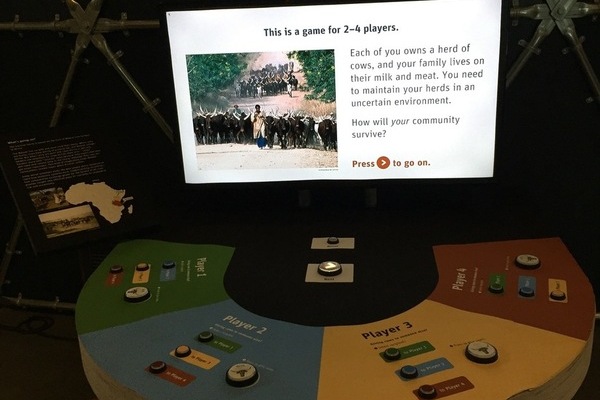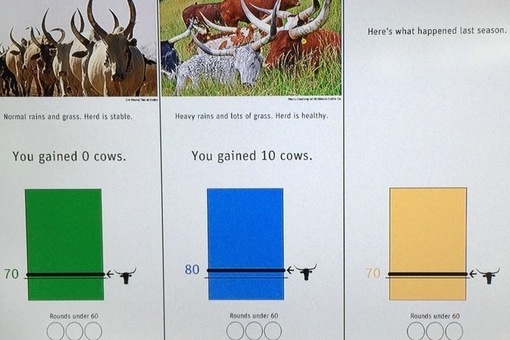Exhibitizing Cooperation
By Hugh McDonald, Ph.D.
Exhibition Consultant and Principal Investigator, Science of Sharing Project
“No way! I lost a lot of cows last year!” is not something you’d expect to hear on the floor of a science museum. But with the introduction of an interactive exhibit called The Survival Game, modeled on a resource-sharing system used by East African pastoralists, discussions about livestock are becoming more and more common at the Exploratorium, San Francisco’s museum of science, art, and human perception. The result of a collaboration between the museum and The Human Generosity Project, the exhibit is designed to engage visitors in the challenges of surviving in an uncertain environment—and the potential communal benefits derived from asking for and giving assistance to those in need.
The Exploratorium and other interactive science museums have traditionally focused on exhibits that allow guests to explore natural and physical phenomena—things such as light, color, sound, motion, electricity, and magnetism. They also sometimes provide visitors with hands-on experiences on topics in biology, chemistry, or other areas.
But until recently, interactive exhibits on topics in the social and behavioral sciences have been rare. One reason is that they’re harder to plan and more difficult to script. Developers working with physical phenomena may have a good idea of the kinds of experiments visitors will engage in at such exhibits; in fact, that knowledge may be key to building an exhibit that compellingly illustrates a specific idea. But because humans are complex and often unpredictable, the behavioral possibilities of an exhibit on cooperation, negotiation, or collaborative problem solving may be harder to plan for in advance. Moreover, exploring ideas like these may lead to interactions that are intimidating for museums—things like disagreements about fairness, arguments about ethics, or confrontations about cultural norms and values.
The Survival Game exhibit suggests that these topics can in fact be engagingly and compellingly explored on the museum floor. The exhibit asks visitors to take on the role of a Maasai pastoralist and make decisions about whether and how to share cows with other players. For many members of pastoral communities in East Africa and elsewhere, wealth and security are measured by the number of cattle one owns. When calamity strikes in the form of famine, flood, or disease, the only option for supporting a family may be to ask others for cows to supplement a diminished herd. With such an event in mind, Maasai form partnerships that they refer to by their word for “umbilical cord”: osotua. Osotua partners agree to help each other in times of need, but only if asked and only if they can do so without jeopardizing their own survival. Fieldwork, laboratory studies, and computer simulations conducted by The Human Generosity Project have shown that, by acknowledging the importance of interdependence, the osotua system helps ensure community survival in an uncertain environment. When the future is unpredictable, it makes not only ethical but also economic sense for me to help you when you’re down, because I will probably be in the same position at some point in the future… and when I am, I’ll need to depend on you.
The Survival Game lets Exploratorium visitors experiment with economic exchanges in such situations, and with the social and emotional ramifications of those choices. The goal of the exhibit is only vaguely defined, and “correct” decisions are left unspecified. It’s up to visitors themselves to decide how to respond when they see others in need (or when they’re in need themselves), to determine what it means to “win” the game, and to learn through experience that helping others may not only make them feel good but is in the long-term interest of the community. And in addition to its learning and experiential goals, the exhibit was also designed to gather data on visitor behavior, such as when players share with others, when they refuse, and how groups of players fare over the long term.
Visitors seem deeply engaged with the exhibit and the ideas behind it. Typically, Exploratorium visitors spend an average of about 1-3 minutes at an exhibit. But at The Survival Game, the average time spent has been measured at over 10 minutes. And visitors’ comments conveyed their engagement with the experience:
“If we die, we die together!”
“You could have saved me!”
“If you give me 5 more, we are all ok.”
“Oh no, Nana is really in trouble.”
“Oh no, mommy. I’ll give you some.”
When it was completed, The Survival Game joined a larger Exploratorium exhibition called The Science of Sharing. The experiences in this collection let visitors play with concepts like trust, fairness, and equity through exhibits that highlight social tensions and dilemmas, including the Prisoner’s Dilemma and the Tragedy of the Commons. How do we interpret social situations when choices seem to be between me and us? Between us and them? How do we balance short- and long-term thinking, or make decisions about maintaining and sharing limited resources? The broader goal of exhibits like these is to get people to experiment with social phenomena just as they do with physical phenomena, and to prompt reflection and discussion on the social psychology underlying some of the world’s most pressing problems. Exhibits like The Survival Game represent a new frontier in exhibit development—and in innovative collaborations between researchers and museum professionals.
Acknowledgements
We thank all of the developers and scientists at the Exploratorium and the Human Generosity Project for their assistance in creating and testing this exhibit. Funding for the development of the Survival Game was provided by the John Templeton Foundation. The Science of Sharing exhibition was funded by the National Science Foundation (NSF #1114781). Any opinions, findings, and conclusions or recommendations expressed in this material are those of the authors and do not necessarily reflect the views of the funders.
SHARE THIS PAGE:


